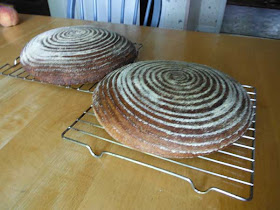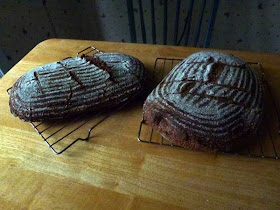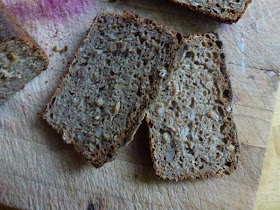Summer heat
Midsummer. A hot spell that never seems to end. The heat is getting to people. Tempers flare; patience wears thin.
My friend is hospitalized and tells me the nurses who look after her are mean -- the very people who are trained to care, are not caring. My heart breaks (for my friend, and for my chosen profession too), but I know that the heat is wearing at me as well. I feel my own energy level drooping, my emotional armour wearing thin as sweat.
In the news, we find polls suggesting that due to the heat, more people are convinced about global warming. Air conditioners are cranked up, making it all that much worse.
Crops are drying up in the fields, throughout the American midwest. The people of the U.S. hungrily eye our Canadian fields of wheat, our recently rained-upon corn. "Ah, we will buy our food from the land of water to the north," they say, smacking their lips.
 |
| sunset over oat fields during a recent dog-walk |
I drive by the recently harvested wheat fields, and the still-tall green fields of corn, monocultures all. I walk the dog at dusk by the edge of a field, scoop up a handful of oats. The sun shines on gold. Farmers fall asleep happy, exhausted, fulfilled. There will be food, there will be money. Our debts will diminish. But the prices for our own grain will rise. Bread will become more expensive. To make. To buy.
And cold will return with a vengeance to our northern lands when winter comes. Today we can sleep, eyelids heavy as we live with the heat, and try to put off thoughts of the distant future.
These days the heat is withering to plants, people and animals caught in the humidity. Stormclouds rise on thermals, but the rain is spotty and infrequent, it always falls elsewhere. It is so hot, even the kundalini is lethargic. It sleeps like a lazy dog in the shade of my muladhara chakra (or so I'm told). Too hot even to do hot yoga. Too hot to go out.
I stay inside and think about bread.
Baking bread
Gotta be nuts to be baking bread when its this hot.
I bake bread.
What can I say? I have this monkey on my back. I have this need. I must have bread. But not just any bread. I must have whole grain bread. Bread you simply cannot buy, anywhere, at any price. Jonesing for my bread. Help me, oh help me.
I made yet another sourdough pan integral. It's a whole wheat bread, nothing' but whole wheat. Oh, I've got a sourdough starter, but its made of whole wheat too. Water, salt, and to ensure that the whole wheat is truly whole, there is some wheat germ in the same quantity that the millers take out. I've done this before. Its becoming old hat, the standard bill o' fare.
But the sourdough culture is performing too fast, in this heat. Everything else in the world is lethargic, is fat-assed, is dragging butt, yet the yeast and bacteria in my culture love the moist warmth, and just bubble away like crazy. My microbes typically raise a bread in 8 hours, but these days it probably only takes 6. Or less. Who knows? I keep missing the optimal baking time. My dough is always overproofed. It drips over the basket top, it flattens out in the oven.
But oh, how it tastes. Schmeckt gut. Help me, but I love this bread.
Notes on Reeds
Not all plants perform poorly in near-drought conditions. In particular, I've been noticing this year the proliferation of a certain species of tall reed, which seems to thrive in alternating conditions of wet and then drought. I've probably only noticed it at all because of my interest in bread, and therefore in grass of all kinds.
Here is what I've observed: these days, along the highway 401 corridor (Canada's Transnational Highway), and along other major highways throughout our provinces, one can find a very tall, invasive grass species whose seeds are being spread by the wind of transports and cars passing at high speeds. When I was a kid you never saw these tall reeds, but in the last few years it has spread quickly. The tall grasses seem to favour low lying, presumably wet areas like ditches and marshlands. And they grow tall when it is quite dry, soaking up all the ground water, and crowding out all other vegetation.
 |
| Photo from Great Lakes Commision |
As I've said, my interest in the reeds has grown because of my interest in all grass species due to my curiosity about all things bread and grain. I originally thought it might be fun to try to use some of the stalks of these huge reed to make bannetons (but now I believe that these dried reeds are probably not going to be bendy enough, no matter how much soaking you subject them to).
I'm no botanist, but I believe they are an invasive common reed -- one of the European versions of Phragmites australis (not the subspecies americanus, but possibly Phragmites australis subsp. australis.). This is a fast-spreading species that began invading our wetlands. I read several studies of how these reeds are growing in the St. Lawrence River, and in many points of land that jut out into the Great Lakes (e.g. Long Point, Point Pelee, and now along the coasts of Lake Huron too). It grows by seed transmission and by rhizomes and stolons, and typically crowds out all native species, destroying habitat for wild animals, especially birds. Once established it quickly becomes a monoculture and displaces cattails, native grasses, sedges and forbs.
There are few good methods to eradicate this grass, if one cares to try. See the resources linked from here. But the Ontario Ministry of the Environment has taken it upon themselves to try (see Invasive Phragmites – Best Management Practices, Ontario Ministry of Natural Resources, Peterborough, Ontario. Version 2011, for example, One chemical means has been the use of glyphosate products designed for aquatic use (e.g. Rodeo, AquaMaster). Which brings me to the study of glyphosate -- because in Canada, glyphosate is a well-known problem for aquatic species.
And there's the rub. Is it better to try to control this weed with a chemical that disrupts aquatic species? Or is it better to just let things be?
Glyphosate
The story of agriculture these days can be told through the lens of this chemical alone. We use a lot of it to drive the weeds back. We genetically modify our wanted crops (corn, canola, soybeans, cotton, etc.) to make them resistant to glyphosate, while the weeds wither under the spray. And we are continuously told that glyphosate affects the biosynthesis of amino acids that plants have, but humans do not. It targets the growing weed's pathways of amino-acid construction, but since humans and other animals do not have this pathway, we are told it is safe for us to eat.
Yet a growing number of people are alarmed at the amount of this chemical in our food, in our environment, and they realize that it isn't completely understood what the effects of it are. For example, use of it is so prevalent, it is now found ubiquitously in our urine. Is that a good thing, or a bad thing? It is in our bodies, and we excrete it -- that's good, right?
Except that some European studies are starting to surface that suggest it may be harmful to internal organs. And it may not break down in the soil as quickly as once thought, and it may increase soil pathogens, and bind to nutrients in the dirt that our crops need to thrive. Furthermore, it may be affecting our mentation, reflected in IQ scores.
Because of my interest in bread, and grain, I've been monitoring the burgeoning fields of biotechnology and genetic engineering which have given us transgenic plants. In particular, I am curious about the genetic alteration of wheat, since it is our main bread source, and has been for thousands of years. Yes, wheat has been mutated in recent generations, and there have been many versions of wheat that are genetically modified and the engineers have given it transgenic enhancements in the laboratory. But mostly, transgenic wheat is not yet in our food supply. There is cultural resistance to this, worldwide, but primarily in Europe. And there is a growing movement in North America that says "no." Organically grown grains are taking small but increasing nibbles out of the market share, and organic growers are concerned that once transgenic wheat is grown anywhere, it will threaten their crops with cross-contamination, and super-resistant weeds.
Although genetically-modified glyphosate-ready wheat is probably already sitting in the labs around the world, ready for the green light to sell to farmers, it isn't approved yet for general use (only for occasional test-plots). Our growing wheat is very sensitive to drift of glyphosate, if fields adjacent to growing wheat fields are sprayed with it.
But that hasn't stopped the chemical companies from selling glyphosate directly to grain growers. Glyphosate is already used in wheat production, both for pre-planting "weed burndown" as well as pre-harvesting, because it has been found to make the grain dry faster.
That's right: farmers will generally dump this chemical on wheat fields within a week prior to harvesting it. You are eating it, if you eat grain. Probably a lot of it.
Unless you buy and eat entirely organic. Not everyone can afford to.
There is a lot of info -- including lies, misinformation and propaganda being bandied about by both proponents and opponents of genetically modified foods and even regarding the use of glyphosate. I've read so much about it recently, my head spins, and I don't know what to believe. Good science, the kind that is unequivocal, is difficult to come by.
But in the end, it is going to be our elected officials that give the go-ahead to transgenic wheat. They are the ones who will make the decision. It will be based on their analysis of risk, and they will receive input from scientists and special interest groups. Farmers have had a say in the decision making process, in the past, worried about their markets and crop rotations; Monsanto and other seed and chemical-producing/distributing companies will continue to have a say (and with their deep pockets, they will eventually be able to influence our elected officials); and consumers will have a say, with the ultimate voting power of their pocketbooks (so long as there remains an alternative choice to do so, they may buy organic). We have heard little from millers and bakers and dieticians/health professionals about this issue -- shame on them.
Wheat Futures
There will be winners and losers in the future. Difficult to predict winners, except in the hindsight called history. As the globe heats up, and we change our environment with glyphosate and other chemicals, there will be life forms that thrive -- like invasive reeds, or certain highly adaptable bacteria (like those that I find in my sourdough); and there will be life forms that do not do well -- like frogs, and birds, and probably human beings.
I choose to ally myself with those organisms that thrive. I've tried to eat some of the grass seed the tall reed produces -- it is mostly bran. Perhaps eating the root would be more appropriate (although one should probably look into it to see if it is edible before one goes munching through the wilderness like Euell Gibbons).
Perhaps with some sort of symbiosis using my sourdough, there will be a pathway through to the future. But I suspect that true symbiosis has to happen at deep, unconscious, cellular, hidden levels. What we may yet become will most likely seem frightening to us now.
Perhaps with some sort of symbiosis using my sourdough, there will be a pathway through to the future. But I suspect that true symbiosis has to happen at deep, unconscious, cellular, hidden levels. What we may yet become will most likely seem frightening to us now.
Notes to Myself
- Froze one of these loaves, ate one. I rarely get back to frozen loaves. But I'm thinking I might require a loaf when I return from holidays.
- This was a good loaf, it disappeared in 2 days.
- Keep an eye on your proofing loaves. They are doubling faster in this humid, summer heat.












































